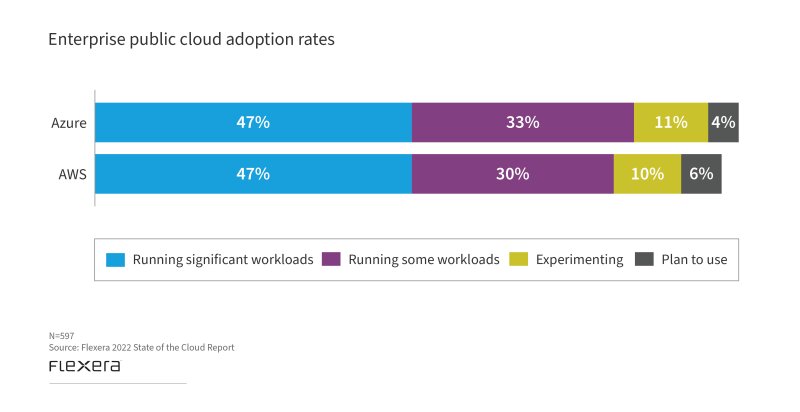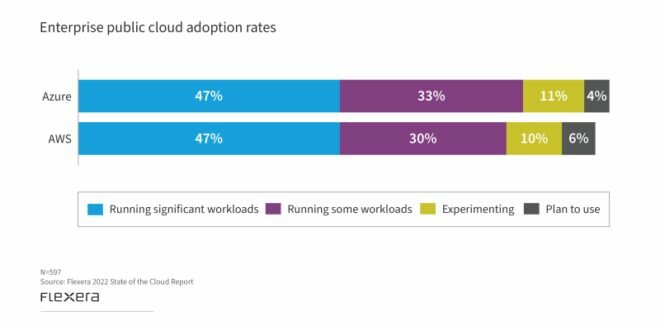
Cloud Usage Statistics – Amazon Web Services (AWS), the profitable cloud platform for online retailers, has moved ahead of the pack, establishing itself as the market leader in cloud infrastructure. According to Synergy Research Group estimates, Amazon’s market share of the global cloud infrastructure market in the second quarter of 2022 was 34 percent, still surpassing the market share of its two biggest competitors, Microsoft Azure and Google Cloud.
Global spending on cloud infrastructure services increased to $55 billion in the second quarter of 2022, bringing the industry total to more than $200 billion over the twelve months. The chart below shows that Amazon and Microsoft accounted for more than half of cloud infrastructure revenue in the three months ended June 30, with the top eight providers controlling more than 80 percent of the market.
Cloud Usage Statistics

As for the impact of unfavorable exchange rates on overall industry growth, John Dinsdale, principal analyst at Synergy Research Group, says global cloud providers are certainly not immune to the impact of continued exchange rate changes. “However, what remains is that the underlying growth in cloud usage continues to grow at a really impressive rate,” he explained, explaining why his company’s forecast shows “strong growth across all key cloud market metrics.”
Where Programming, Ops, Ai, And The Cloud Are Headed In 2021
Yes, allowing easy integration of many infographics into other websites Just copy the HTML code shown for the relevant statistic to link to it Our standard is 660 pixels, but you can customize how the statistics are displayed to suit your site by setting the width and display size. Please note that the code on WordPress pages and other CMS sites must be linked to HTML code (not just text).
Economics and Finance, Politics and Society, Tech and Media, Health and Environment, Consumers, Sports and many more Check out our upcoming releases Cloud computing has evolved into a vast and complex ecosystem of technologies, products and services. Growing into a multi-billion dollar economy with many cloud providers competing for an ever-expanding share of the cloud market.
As a consumer, this cloud ecosystem is more difficult to navigate and understand. Outside of industry giants Amazon Web Services, Microsoft Azure, and Google Cloud Platform, the cloud market remains a mystery to many.
Today, we’re going to dive deep and expand into the cloud market. We’ll define different cloud services, identify the leading cloud providers, and examine their cloud market share in 2022.
Discover And Manage Shadow It Tutorial
We’ll help you figure out how and why businesses are moving to the cloud, the benefits and associated costs.
Before exploring the cloud market and cloud market segments, you must first understand the three main types of cloud computing. Each type has its own range of services and cloud providers that make up the market There are three main types of cloud computing:
IaaS is a cloud computing offering where the provider gives you on-demand access to computing resources such as network, storage and servers. You run your own platform and applications on the provider’s infrastructure It provides flexible hardware resources depending on your storage and processing needs

PaaS is a cloud computing offering where the provider gives you access to a cloud environment where you can develop, manage and host applications. Through the platform, you will have access to a variety of tools to support testing and development
The Cost Of Cloud, A Trillion Dollar Paradox
SaaS is a cloud computing offering where a provider gives you access to their cloud-based software. Instead of installing the software application on your local device, you access the provider’s application using the web or an API.
With the app you store and analyze your data You don’t have to spend time installing, managing or updating the software, it’s managed by the provider
A private cloud is a cloud that you host in your own data center or on the Internet Own, manage, update and upgrade your own cloud ecosystem of servers, networks, software or platform resources. Protect it with your own firewall and security solutions
A public fair is where the provider gives you access to the data center infrastructure They are responsible for all management, maintenance, security and upgrades
The Most Common Cloud Misconfigurations That Could Lead To Security Breaches
A hybrid cloud is where you choose to use a combination of both public and private cloud solutions. You are responsible for managing the interaction between the two services, particularly data security between both public and private cloud settings.
Cloud computing market is huge Seven major segments, operators and vendors of the cloud services and infrastructure market report more than $150 billion in revenue for the first half of 2019, according to new data from Synergy Research Group. 24% increase over last year
As the cloud market has grown, there is ample opportunity for expansion, especially considering that Gartner projects global IT spending to reach $3.79 trillion in 2019.

In a comprehensive look at the segments that make up the cloud market, public cloud solutions make up the numbers. This closely aligns with the RightScale 2019 State of the Cloud report. Accordingly, 91% of enterprises report using a public cloud service, 72% choose a private cloud solution, and 69% choose a hybrid solution.
Why Cloud And Esg?: Pwc
Based on IDC estimates, global spending on public cloud services and infrastructure is projected to double over the next five years. This is not surprising when you consider the benefits of cloud computing from a factor of $229 billion in 2019 to almost $500 billion by 2023. Conditional on five-year compound annual growth rate (CAGR).
The IDC report cites SaaS as the largest spending category, accounting for more than half of public cloud spending over the forecast period. IaaS is the second largest spending category and the fastest growing with a five-year CAGR of 32.0%. PaaS is the lowest cost category with the second largest five-year CAGR of 29.9%.
For a more detailed study of the public cloud market, we should go to Alternative Research and Reports
Software as a service is the most mature public cloud market, showing healthy growth The latest data from Synergy Research Group reports that software vendors generated more than $23 billion in revenue in Q1 2019.
Sap Analytics Cloud (sac): Analyzing Usage / Collecting Statistics
Sustaining a $100B+ Market at Annual Launch Rates The report shows nearly 30% year-over-year growth, in line with IDC’s aforementioned global public cloud spending guidance.
Five Big Vendors Dominate the SaaS Market These SaaS vendors together account for 51% of the global SaaS cloud market.
Microsoft being Microsoft With 17% market share and 34% year-over-year growth, Microsoft continues to experience market growth, largely due to its dominance in the high-growth collaboration segment.

Salesforce has 12% SaaS market share and 21% year-over-year growth Followed by Adobe with 10% SaaS market share and 29% year-over-year growth Next is SAP, trailing the aforementioned vendors with 6% SaaS market share and 39 % annual growth – most of the top five sellers. Finally, Oracle holds a 6% market share and reports 29% year-over-year growth
File:use Of Cloud Computing Services, By Economic Activity And Size, Eu 28, 2014 And 2018 (% Of Enterprises).png
The next ten vendors accounted for another 26% of the SaaS market, with 26% growth These vendors include Cisco, Google, IBM, Service Know, and Workday.
Despite the maturity of the SaaS market, there is a huge opportunity for expansion. As the current SaaS market only accounts for about 20% of enterprise software spending. As enterprise software spending is focused on on-premise software solutions, SaaS vendors are moving into this market to attract businesses to the cloud. settings.
In 2019, the SaaS vendor landscape is largely divided into three camps: traditional enterprise software vendors, cloud-born vendors, and large IT vendors looking to expand into the marketplace.
This camp includes the big names you’d expect, like Microsoft, SAP, Oracle, and IBM. They have a huge base of existing premier customers that they would like to convert to a SaaS based subscription model.
Strategies For Maximizing The Value Of Cloud
These relatively new companies are experiencing rapid expansion with high growth rates They have the likes of Gendesk, Workday and Atlassian What they lack is the massive recognition of the Microsoft brand in this world
Making a play for the SaaS market, the group includes companies like Google and Cisco Carving out a niche in the market with services like Google Workspace and Cisco’s collaboration apps.
When it comes to getting an accurate picture of the IaaS and PaaS market, things get a little complicated. Leading vendors in this space, including Amazon and Microsoft, often report combined IaaS and PaaS revenue.

Add to that the lack of transparency in their reporting disclosures, and it’s easy to see why getting a true picture of the market is so difficult. Fortunately, reports from leading research agencies such as Gartner and IDC help us gain a deeper understanding.
Mobile Vs. Desktop Usage In 2020 / Perficient, Inc
Gartner’s most recent data on the global infrastructure as a service market shows annual revenue of $32.4 billion. A 31.3% increase from $24.7 billion in 2017
According to Gartner, five vendors dominate the market
Cloud computing usage statistics, chatbot usage statistics, cloud usage, california water usage statistics, cloud storage usage statistics, social media usage statistics, app usage statistics, mobile usage statistics, debit card usage statistics, water usage statistics, mobile app usage statistics, usage statistics
 GoInspiration | Best Forex, Stock, Gadget, and Internet Information Apps
GoInspiration | Best Forex, Stock, Gadget, and Internet Information Apps